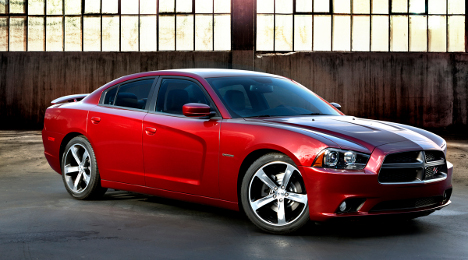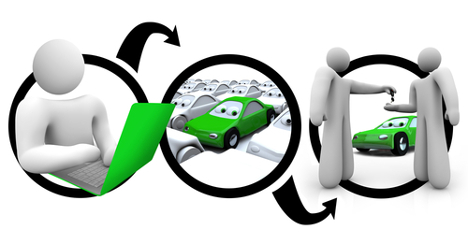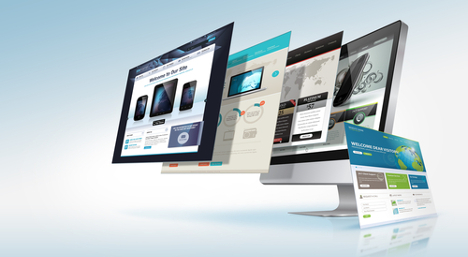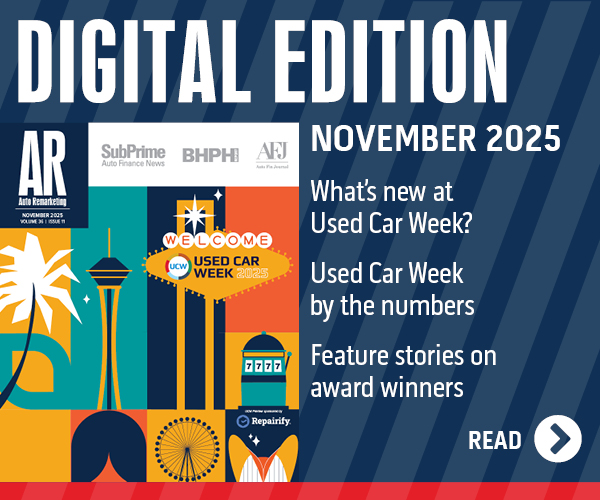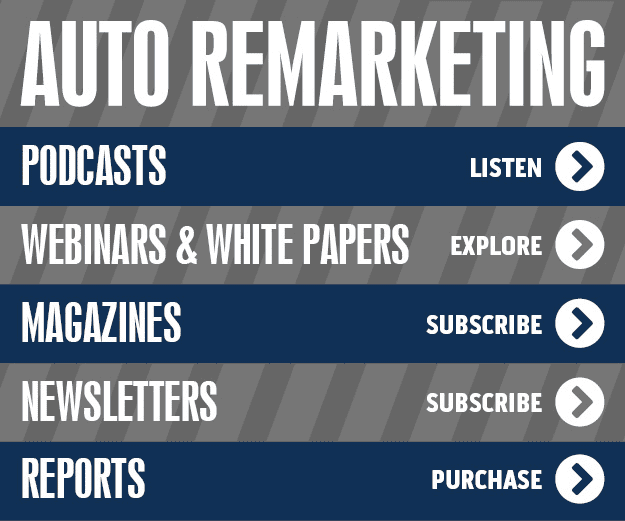Imagine you’re a car shopper.
Like many of your peers these days, you’re doing most of the car-shopping process — researching the vehicle, comparing prices, reading dealer reviews, checking out history reports, etc. — on your smartphone.
You spot a dealership you want to look up. Which of the two URLs is going to be easier to type into the URL bar: JoeSmithofMontana.com or Joes.cars?
Heck, which one is going to be easier to remember?
That’s part of the thinking behind Cars Registry, which launched auto-specific domain extensions .Cars, .Car and .Auto on January 20. Cars Registry is the registry operator for those domain names and was founded last year by XYZ and Uniregistery.
“Now there are more car-shoppers that are researching and buying cars on their mobile devices … if you’re JoeSmithofMontana.com, that’s going to take 10-20 seconds to type into your URL bar,” Cars Registry chief operating officer Mike Ambrose said in an interview here at the NADA Convention & Expo. “If you’re Joes.cars, it gives users a quick, easy access to your website. And it really ensures that branding, so visitors don’t get confused.”
Ambrose added: “We want dealerships to have the ability to secure that one word or that easy-to-remember domain name, so their visitors can easily access their site, because the domain name is the foundation of your digital marketing. And if dealerships are sending thousands of dollars on SEM and digital marketing activities, they want to be driving traffic to URL that makes sense, that’s short, that’s memorable. And that’s the first opportunity that we want to give dealerships.”
Since the launch, there has been an array of auto business types who have started using the domain names. That includes dealer groups, individual dealerships, tech companies like Google and Apple and automakers.
Non-automotive companies that have a presence in automotive are able to use it build website on auto-specific domain, cater specifically to their automotive offering
As for dealers specifically, Ambrose said hundreds registered domain names and at the time of this interview at NADA Convention & Expo, between 20 and 30 had had moved their entire website over to new domain name.
“This opportunity allows them to register their first-choice domain name that’s actually automotive specific. So if you’re JoesChevyInMontana.com – a four-word dot-com domain name – you could get Joes.cars or Joes.auto,” Ambrose said. “Something really short, memorable, mobile-friendly. It’s like a reset on the Internet name space, and dealerships can finally get the domain name that they’ve always wanted.”
There’s also a regional benefit to this, he said, where dealerships can “own” their city or region. For instance, he said, a Toronto dealership could get Toronto.cars or Toronto.auto.
“So, they can actually build a new website on this regional domain name and start to get leads for organic keywords relating to that search term,” Ambrose said. “Google puts preference on exact-match domain names.”
He gives the example of the Kansas-based Schofield Automotive, which registered Wichita.cars.
Ambrose added: “It’s a digital marketing asset that dealerships are using to get more customers in the door through Web leads.”
So, say you’re a dealer and you get a new .cars or .auto extension. What about the old website?
“Dealerships can either redirect their new domain name to their existing website, for defensive purposes and to protect their mark, so they can redirect it to their dot-com domain name. But we recommend that they do the reverse; so they redirect their old legacy dot-com domain name to their new domain name,” Ambrose said. “Because we’re seeing that dealerships see improvements in their search-engine ranking by switching over to the new domain name.
“And Google’s actually giving preference to the new automotive domain endings as opposed to the old dot-com domain ending, which could be for any business, whether it be a spammer or a photographer or a yoga instructor,” he added. “Anyone could be on a dot-com. “
Typically, only an auto-related business would buy a dot-auto domain name, for example, Ambrose said. And the company aims to ensure there is “only clean activity in our name space,” he said.
Fiat Chrysler Automobiles and shopping website CarGurus announced an agreement on Wednesday that provides the automaker’s franchised dealers an opportunity to advertise and post their certified pre-owned vehicle inventory on the CarGurus site.
Executives highlighted the agreement puts dealer CPO vehicle inventory in front of 20 million monthly unique automotive shoppers on the CarGurus website and gives FCA dealers access to the platform's top-performing lead generation and display advertising programs.
“As our dealers drive continued growth with CPO, it’s important that we support their efforts to get these vehicles in front of as many shoppers as we can," said Eric Swanson, head of certified pre-owned vehicles at FCA US.
“In partnering with CarGurus, we are opening a new channel to expose these great vehicles to highly engaged buyers,” Swanson continued. “We’re confident that CarGurus will help us generate quality leads for our stores and tell the CPO story in ways we never could before.”
Founded in 2007, CarGurus uses technology and data analysis to help consumers search their local market for the best vehicle deals, and then connects shoppers with listing dealerships. CarGurus works with dealers and OEMs to incorporate their inventory feeds on the site, and offers dealerships a range of high-performance lead generation and audience extension advertising packages.
“We are excited to bring more FCA US certified pre-owned vehicle choices and brand information to CarGurus shoppers, and we look forward to working with FCA US dealerships to help them reach our audience with the most efficiency and impact,” said Frank Weishaupt, senior vice president of audience sales at CarGurus.
“There's no question that CPO is becoming an important consideration for car buyers, and aligning with brands like FCA to tell their CPO story allows us to help our users make the best buying choices,” Weishaupt continued.
Dealers interested in learning more about CarGurus free and paid subscription programs should contact the FCA US Certified Pre-Owned Vehicle group.
Five trends uncovered in new research from CDK Global reinforced how much vehicle shoppers are willing and likely to start the buying process online.
In a recent survey, CDK found that nearly 70 percent of shoppers expected to find the ability to configure a payment on a dealership website, and 83 percent indicated that online buying technology would help them narrow down their vehicle choice and determine what is affordable.
Two other key findings from the survey include:
— 80 percent of shoppers say they would likely configure a payment online
— 60 percent said they would configure a payment and provide contact information
Also of note among those shoppers surveyed, more than half said they would configure a payment and start the credit process.
The research comes soon after CDK recently introduced an online vehicle buying solution for dealers in the United States — CDK Connected Store.
The new solution can provide a personalized and seamless experience for customers and flexibility regarding how much information they have to enter prior to visiting the dealership, from simply configuring a potential payment to actually starting the credit process. The solution can fully integrate with other CDK solutions, including Sales Velocity and dealer websites.
“Consumers have clearly indicated that they expect dealers to offer the ability to start the car buying process online," said Bob Karp, president of Automotive Retail North America at CDK Global.
“Interestingly, our research found that among those same consumers, nearly 60 percent felt more comfortable starting this process on a dealer's website compared to third-party sites,” Karp continued. “Dealers have a big opportunity to improve trust with this new technology, and to reduce the purchase time.”
Through a four-step process, CDK estimates that customers and dealers can save up to 90 minutes in the car buying process though the Connected Store solution. Customers can complete key areas of the deal structure including:
— Select a down payment. Customers can enter how much they would like to put down on their potential vehicle purchase.
— Determine trade-in value. Through Edmunds.com, users can estimate the value of their trade-in. They can subtract their current loan amount from the value of their current car.
— Calculate taxes and fees. Customers can determine the taxes and fees based on their address.
— Obtain credit information. When customers enter their information they can run their credit and determine their score and credit tier. Alternatively, customers may simply estimate their credit rating. They can then select finance or lease options, including terms and miles for the lease.
“What makes our solution unique is that it bridges the online experience seamlessly into the store,” Karp said. “The integration with the DMS and our desking solution also helps ensure that the consumer and the dealer have payment information that matches the online quote.”
CDK's Connect Store solution is currently available to dealers with both a CDK-provided website and a CDK DMS in the United States.
For more information, visit www.cdkglobal.com/connectedstore.
It seems like everywhere you turn, there is an immense amount of conversation and pressure to drop your current dealer marketing strategy and throw all your eggs into a new basket, such as direct marketing, social or mobile.
These “wave of the future” strategies have promise, and there’s even some decent ROI associated with each. But what about finding a better way to do what you’re currently doing in terms of customer marketing?
Some habits are hard to break in the automotive industry. And to be honest, some don’t have to be broken, especially if you can simply find a better way. This is exactly what’s happening with dealers and the way in which they market to their customers.
Marketing works, but the method is failing
The problem isn’t necessarily at the tactical level. Direct mail still works. Equity marketing remains highly effective. DMS information is ripe with accuracy.
In reality, the biggest problem is the way in which all these components come together. The process is disjointed. It’s frustrating and inefficient. And, worst of all, it’s costing many of you millions of wasted dollars.
Dealer profits already being squeezed
It’s important for dealers and their marketing partners to re-evaluate the way in which customer marketing campaigns are developed and managed, and many of the reasons are financial. Dealer profits are shrinking, mainly due to shrinking margins on the sale of new and used vehicles. According to Henderson, Hutcherson and McCullough’s (HHM) recent auto dealer economic outlook, the gross profit margin for dealers fell from 13.5 percent down to 13.3 percent.
The report also stated that the average new vehicle gross profit fell from $1,204 down to $1,193. Gross margins also declined from 3.81 percent down to 3.68 percent.
Furthermore, according to research firm, Statista, the average-size dealership (selling between 150-399 cars annually) spends approximately $616 on advertising per each new car sold. This number goes up as dealer size shrinks. The firm points out that dealerships selling between one and 149 cars annually are faced with a per-car advertising spend of $862. This spend can be lowered simply by consolidating the different touch points involved in the development of campaigns.
Six different calls for one outcome
Currently, if a dealer and his/her marketing agency want to pull together a new customer marketing campaign, there are six different vendors who must participate in that process.
- DMS: The vendor who runs the central hub of vehicle and customer data that often serves as the backbone of each campaign.
- Consumer auto data: Vendor who holds intimate demographic data on would-be car shoppers.
- Incentives: Vendor who holds vehicle sales data that can help set incentives and other offers for the benefit of the car shoppers.
- Vehicle pictures: Vendor who helps with the visual marketing of each vehicle, so that each customer is enticed into learning more.
- Vehicle values: Vendor who provides all necessary data on the vehicles accurate valuation.
- Printer: Vendor who takes the essence of the campaign from the marketing agency and builds the direct mail piece, plus shipping logistics.
When the dealer and marketing agency want to build and execute on a campaign, all the correspondence and planning between these six different vendors takes time, as well as individual markups that can drive up the campaign cost (and erode dealer profits).
Where do we go from here?
This should serve as a wake-up call for dealers and their marketing agency partners. The industry needs to collectively find a better way to streamline the process for developing and executing customer marketing campaigns. By doing so, dealers will begin to drive more costs out of the equation, which will help offset the pain they’re feeling on the balance sheet.
Editor’s note: Jared Kalfus is senior vice president of sales for Black Book. For more information, visit www.BlackBookAuto.com.
Kelley Blue Book launched two all-new integrated marketing campaigns on Monday aimed at both franchised and independent dealerships as well as informing consumers about how much information and experience the company has to help buyers through the vehicle selection and purchase experience.
With more than nine decades of experience to leverage, Kelley Blue Book insisted its storied history makes it the most influential site for shoppers choosing a dealership, which can help clients “get results out of the blue.”
Based on that idea and research showing 68 percent of KBB.com shoppers are planning to purchase a vehicle within the next two months, the company’s multi-point “Out of the Blue” marketing campaign is directed at franchise and independent dealer audiences.
Officials highlighted the campaign brings to life how Kelley Blue Book is shifting from a marketplace to matchmaker strategy, bringing the right buyers to the right dealership through an experience and purchase that can make all parties can feel good.
KBB mentioned the marketing campaign will include print media, display advertising, retargeting and pre-roll video, reaching 90 percent of franchised and 25 percent of independent dealers.
“Kelley Blue Book lends its brand equity, competitive traffic levels of in-market shoppers and strong pedigree within the industry to help dealerships achieve their respective goals,” said Jessica Stafford, vice president of marketing at Kelley Blue Book’s parent company Cox Automotive.
“The company’s all-new campaign supports that mission by building awareness and perception among dealers that the Kelley Blue Book brand and its products are highly relevant and necessary to drive traffic and reduce friction in the car-buying process,” Stafford continued.
In addition to an existing robust portfolio of products, including classified listings, LeadDriver and more, KBB pointed out some new products for dealer customers include the Kelley Blue Book Instant Cash Offer and the Used Car Highlight module.
— Instant Cash Offer: Last year, Kelley Blue Book provided nearly 100 million trade-in values to shoppers. Now dealers can drive transaction-ready consumers to their showroom, integrating Kelley Blue Book’s Price Advisor to boost confidence and redeem an Instant Cash offer on their current vehicle.
— Used Car Highlight: Dealers can receive a unique opportunity to make an immediate connection with in-market shoppers using Used Car Highlight. As consumers receive a price for their configured used vehicle, this widget matches the most relevant vehicle from local participating dealers to the consumer search criteria.
More details about consumer endeavor
Debuting on Monday as well, the “Get New Car Smart” campaign is designed to reposition the brand and shift perceptions of KBB.com from a used-vehicle pricing and valuation destination to the definitive, go-to resource for new-model shoppers. At its debut, the campaign can be seen across cable, network and streaming television platforms, digital media, including radio, and also on social media and through public relations initiatives.
“For the majority of car shoppers, KBB.com historically has been known as the trusted destination for used-car pricing and valuation,” Stafford said.
“But KBB.com has so much more to offer, including unparalleled tools to help shoppers understand what they should pay for a new car, along with award-winning expert editorial content that helps consumers narrow their consideration set and ultimately choose the car that best suits their individual needs and wants,” she continued.
KBB reiterated that the average shopper spends 15 to 17 hours online researching and visits three dealerships during a span consisting of more than 15 weeks before buying their next vehicle. Kelley Blue Book boasts comprehensive expert editorial reviews and ratings, recommendations and other helpful new-car buying tools.
With the Kelley Blue Book Price Advisor tool, KBB.com offers vehicle shoppers the ability to understand how much they should pay for their new vehicle based on what others have paid for similar cars in the area. In addition, new-car buyers can find the Fair Market Range, 5-Year Cost to Own information, expert and consumer ratings, new-car buying guides, new-vehicle reviews, top 10 lists, segment comparison tests, data/specs on the cars they are interested in and more.
The campaign highlighting all of these resources targets men and women 18 to 49 years old who are in-market shopping for a new vehicle, and seeking knowledge from an objective, trustworthy expert, as well as reassurance and a sense of confidence as they make decisions throughout the new-car buying process.
The creative was developed with Los Angeles advertising agency Zambezi, Kelley Blue Book’s first collaboration with the agency, which also represents Autotrader, another Cox Automotive company. The new spot, “That’s Pretty Smart,” will be shared in three formats (60 seconds, 30 seconds and 15 seconds) across television, social and various digital channels.
The 60-second spot can be seen in the video at the top of this page.
This is the second TV campaign for the nearly-100-year-old brand, which debuted its inaugural ad campaign in summer 2012. The additional agencies supporting this campaign include 360i and Citizen Relations.
“Kelley Blue Book has long been The Trusted Resource for car shoppers and is the most visited third-party automotive website," said Josh DiMarcantonio, executive creative director at Zambezi.
“We built the marketing campaign on the idea that the brand offers a wealth of tools and information that helps car shoppers along their path to purchase, so anyone in the market for a new car can become a master new car shopper by visiting KBB.com,” DiMarcantonio went on to say.
CDK Global believes more than 73 percent of consumers prefer to do business with brands that make their shopping experience more relevant.
With that metric in mind, CDK Global contends the company now can personalize the online consumer experience for dealerships’ new- and used-vehicle sales endeavors as well as their parts and service profit centers through new personalization capabilities and expanded content on the Consumer Interest Network.
Shoppers will now receive content, offers and information relevant to where they are in the buying and ownership process, according to Max Steckler, who vice president of product management at CDK Global.
“Personalization pays for car dealers, and it's something that consumers have come to expect,” Steckler said. “According to our research, consumers who experience personalization engage with 53 percent more VINs and perform 58 percent more vehicle searches on dealer sites.
“Additionally, we’ve found that there is a 28-percent increase in likely buyers for dealers who have implemented our personalization solutions,” he added.
The company acknowledged that vehicle research happens on sites all over the Internet, and CDK Global is connected to a broad set of research points through its Consumer Interest Network, which can allow for personalization to occur.
This penetration includes dealer and select manufacturer websites, automotive research portals and other third party websites, including Edmunds.com.
Additionally, CDK Global has recently entered into a relationship with Contact at Once that can enable dealers to see what vehicles customers are shopping for on their website in real time. The integration will also allow for the sharing of customer interest data to enable dealers to personalize live online chat interactions with their customer.
“One of our latest innovations in personalization and a first for the industry connects customer actions in the dealership to their digital experience,” Steckler said. “Customers who recently purchased a vehicle don’t want to see advertising for a new car, so we can instead show them content about servicing the vehicle or purchasing accessories.
“We’re able to follow the customer's journey from online to in-store by connecting DMS and digital data — with the goal of keeping the dealer at the center of the experience,” he went on to say.
To learn more about the solutions offered by CDK Global, visit this website.
Dealerships of all sizes are trying a wide array of strategies to reach millennials — individuals born between 1982 and 1994 — in order to keep vehicles turning and service bays humming.
J.D. Power recently released what analysts titled the Millennials Insight Report: The Customer Experience Perspective; a report aimed at defining the quintessential makeup and customer experience preferences of millennials
The following five points are a sampling of the report’s highlights:
• Millennials are not as fickle or anti-establishment as you think: Overall, across the 15 industries studied, millennials are generally more satisfied consumers (5 points higher, on average, on a 1,000-point scale) than Boomers (born 1946-1964). The difference is most prominent in the utilities (plus 37 points), healthcare (plus 28 points) and telecom (plus 13 points) industries.
• Customer Service Is critical to millennial loyalty: Millennials have the lowest tolerance for errors and delays of any other generation studied — they simply expect things to work. However, when there is a problem and it is resolved fully, millennials are substantially more likely than Boomers to reuse a product or service.
• Value for money is king: The secret to millennial satisfaction? It’s value for money. Unlike other generations that tend to buy things for status, image or brand loyalty, millennials are most likely to make a purchase decision based on value for money — across virtually every product category.
• Privacy: What’s in it for me? Millennials are less concerned than other generations about privacy. They accept the erosion of privacy as inevitable and are generally willing to have their information collected if it comes with benefits in the form of targeted offers and personalized services.
• Optimism abounds: Despite having lower accumulated wealth, less income and higher debt than other generations, Millennials are much more optimistic about the economy and their own personal financial outlook.
“Our studies indicate that millennials are different from previous generations; however, it’s really the nuances of the customer experience that set them apart from the rest,” said Keith Webster, senior vice president and general manager of service industries Americas at J.D. Power.
“And it’s those nuances that are so critical for business leaders to know right now as they wrestle with the challenge of anticipating customer demand in an incredibly fast-moving marketplace where getting it wrong can have catastrophic effects,” Webster continued.
“We believe this research helps to demystify the millennial generation by offering concrete data on their real-world consumer interactions,” he went on to say.
By digging deeper than ever before into the millennial customer experience, J.D. Power believes the Millennials Insight Report can deliver a detailed look into the hearts and minds of this “chronically misunderstood” generation.
For companies that want their brand promises to resonate with millennials, J.D. Power stressed that understanding the subtleties and nuances that both differentiate and connect this generation with others — as well as providing products and services that cater to their individual requirements — is essential.
Considered the most comprehensive report on millennials to date, J.D. Power highlighted the inaugural report is based on in-depth proprietary benchmark research, analyses and insights gleaned from more than 600,000 consumer responses (126,315 from millennial consumers) and interviews with verified customers derived from nearly two dozen J.D. Power syndicated studies conducted in 2015 in the United States.
“So much has been written about millennials, yet much of the information provided is just one very small slice of their total makeup and is often limited to just one industry,” said Jay Meyers, vice president for the analytical center of excellence division at J.D. Power. “The Millennials Insight Report is a one-of-a-kind analysis providing a 360 degree perspective and showing that the millennial generation is a heterogeneous group that is simultaneously very different from and — in some ways — very similar to other generations of U.S. consumers.
“For businesses catering to this generation, the insights uncovered in our report provide a starting point for understanding the nuanced approach required to build real, lasting engagement,” Meyers went on to say.
The full report contains a wide range of data points and analyses that capture millennials’ voice of the customer experience, covering such business segments as automotive, banking, credit card, hotel, wireless, investments, primary mortgage and health insurance, as well as Internet and media usage.
For more information about the Millennials Insight Report: The Customer Experience Perspective, visit http://www.jdpower.com/millennials.
Mark O’Neil, the newly minted chief operating officer of Cox Automotive, is staying put in Virginia, he tells Auto Remarketing during an on-site interview at the NADA Convention & Expo this past weekend.
He has no plans to move to Atlanta, where Cox Automotive and its parent (Cox Enterprises) are headquartered.
That’s no slight on the city; by all accounts, the company certainly plays an active role in the city’s economy and community.
It’s just a new way of thinking at a company, and within an automotive industry, that’s increasingly global.
While much of Cox Automotive’s leadership certainly still resides in Georgia’s capital, many of its top-line executives are situated throughout the country.
If you think about O’Neil’s direct reports, some are located in Atlanta, yes. But many others are based in places like Carmel, Ind.; Austin, Texas; and Burlington, Vt.
And just as those cities represent various corners and alcoves on the U.S. map, much of Cox Automotive’s business model resembles a cross-section of the retail and wholesale auto industry at large.
Auctions, classifieds listings, vehicle research/pricing guide, inventory management, websites, software, transportation, and so on.
These services, along with senior leadership located throughout the country, reflect Cox Automotive's rapid acquisition expansion in recent years that culminated in perhaps the crown jewel of all the purchases: Dealertrack Technologies, where O’Neil had been chief executive officer.
But it also reflects a changing mindset towards senior leadership and Atlanta: they're “connected, not relocated,” as O’Neil put it.
“I’ve had long discussions with the senior leadership of Cox Enterprises about the importance of building a global company; that if we are going to be a global company, we cannot be Atlanta-centric. Because the world does not revolve around Atlanta,” he said.
Cox Automotive is introducing a new approach, one that will be a “multi-year effort,” where the line of thinking is, “it’s important to be connected to Atlanta; it’s not necessarily important to live in Atlanta,” O’Neil said.
“It’s not necessarily important to think about your job being there, whether it’s my job or (chief product officer Rick Gibbs’) new job,” he said.
“You can be almost anywhere in today’s environment. But wherever you are, you must be connected to all of those who you work with,” O’Neil said. “And that can be a virtual connection; it doesn’t have to be physical.
“And the ideal is probably a hybrid, right? We’re going to do so many meetings a year in person; we’re going to do so many events in person; and we’re going to do so many virtually,” he said.
“And, oh by the way, in between, we’re all going to be at clients and be distributed around doing other things, where we’ll also connect,” O’Neil said. “So, connected, not relocated. It’s also much more efficient for the company.”
Editor's Note: This is the first in a series of stories about Cox Automotive's leadership stemming from Auto Remarketing's interviews with O'Neil and Cox Automotive president Sandy Schwartz at the NADA Convention.
Coinciding with the NADA Convention & Expo, Black Book formed a distribution agreement with ProMax, which the companies think will help expand the footprint of the new Bullseye Prospecting turnkey platform for dealer marketing campaigns.
Under the agreement, the companies explained ProMax will market the Bullseye Prospecting platform to its network of dealers throughout the United States. Powered by data from Black Book, Bullseye Prospecting is designed to reduce and consolidate the many different touch points involved in the development and execution of a customer campaign.
In early tests, officials indicated Bullseye Prospecting yielded impressive results, helping dealers consolidate their marketing efforts while lowering their cost per car sold overall.
Black Book acknowledged that dealers and their marketing partners often work with several different vendors; all who add to the overall cost of production after markups are taken into effect. Bullseye Prospecting is designed for seamlessly leveraging economies of scale for data coming from DMS, consumer, incentives, and vehicle equity and valuation sources.
The program also can leverage partnerships with photo and printer vendors for direct marketing collateral.
“In today’s automotive industry, dealers are looking for every opportunity to grow margin for their bottom line, especially as profits tighten on vehicle sales,” said Jared Kalfus, senior vice president of sales at Black Book. “Bullseye Prospecting helps drive costs out of their marketing campaigns, and ProMax will help distribute this important resource throughout the dealer community.”
ProMax chief operating officer Shane Born added, “ProMax had the opportunity to conduct an early trial of Bullseye Prospecting and the initial testing produced great results for those dealers involved.
“Bullseye Prospecting will change the way dealers plan and executive customer campaigns, with an eye toward efficiency and cost reduction,” Born went on to say.
To schedule a demo of Bullseye Prospecting, call Black Book at (855) 371-7531 or visit BullseyeProspecting.com.
Marketing and advertising company Jumpstart Automotive Group announced this week it will give manufacturers direct access to specific audiences who are shopping for vehicles across its portfolio of sites.
The company highlighted this development dubbed Traxion marks the first time Jumpstart is providing OEMs direct access to its exclusive portfolio of in-market vehicle shoppers.
“Traxion gives our clients the ultimate brand control,” Jumpstart chief executive officer Nick Matarazzo.
“Whether they want to use the data to understand their consumer better or use it to retarget or create custom communications for specific audiences (e.g., undecided shoppers, segment buyers, brand loyalists, model-specific shoppers, etc.), it’s their choice,” Matarazzo continued. “This data product is the missing piece of the puzzle that they've never had before," said.
Jumpstart’s portfolio includes Car and Driver, U.S. News Best Cars, NADAguides, J.D. Power Cars, autoweek.com, Autobytel, Daily News Autos, LeftLane, CarSoup and CarBuzz.
Senior vice president of revenue operations Brian Ledoux added, “We’re excited to offer our clients custom, Jumpstart-curated audiences, as well as new audiences specific to each client's unique needs.
“And pushing these audiences up to our client’s DMPs and DSPs not only gives them the ability to overlap our first-party data with their first- and third-party data for internal analysis, but also allows them to target our audience on open exchanges — giving them full control over which non-automotive sites they want to reach Jumpstart visitors on,” Ledoux went on to say.


